Validity of Anchorage Zone Design for Post-Tensioned Concrete Members with High-Strength Strands
Abstract
:1. Introduction
2. Design Method for the Anchorage Zone
3. Experimental Section
3.1. Specimen Details
3.2. Test Setup
4. Experimental Results and Analysis
5. Conclusions
- The maximum bursting stress occurred at 0.3 h from the end of members, and the distribution aspect of bursting stress in the anchorage zone was similar regardless of anchorage shape when the pre-stressing force was introduced. The design standards assumed that the maximum bursting force occurs at 0.5 h; in addition, the bursting force was estimated as the summation of the tensile forces without considering the offsetting of the bursting stress due to an increased number of strands.
- The strain due to the bearing force of a member with circular anchorages was 12% smaller than that of a member with rectangular anchorages because the circular anchorage efficiently distributed the bearing force when the pre-stressing force was introduced. As the number of strands increased, the strain due to bearing force increased proportionally. The hairpin reinforcement resisted the bearing force most effectively. The transverse spacing of the stirrups was the main variable in resisting the bearing force when reinforcement used closed stirrups.
- The allowable bearing forces calculated by the ACI and AASHTO codes were about 241 kN and 493 kN, respectively, when pre-stressing force was introduced by 320 kN. The ACI code estimated the allowable bearing force to be smaller than the pre-stressing force regardless of anchorage shape. However, the experimental results showed that cracking and failure of the concrete did not occur due to failure to reach the maximum compressive strain. The AASHTO code estimated the allowable bearing force to be approximately 1.5 times the pre-stressing force; this is not suitable for building structures, which have members that are relatively small compared to civil structures.
- The results of the flexural experiment confirmed that additional stress occurred in the anchorage zone as the flexural load increased, which may have been caused by a failure of the anchorage zone; in addition, the circular anchorages were more effective than rectangular anchorages at dispersing increasing bursting and bearing force when flexural load was applied. The concrete strain estimated by bursting force and bearing force was smaller by 40% and 203% on average when applying circular anchorages rather than rectangular anchorages. The anchorage reinforcement designed using current codes could not resist the increased stress. Therefore, design standards should consider a method for anchorage zone reinforcement under ultimate flexural load.
Author Contributions
Funding
Conflicts of Interest
References
- ACI Committee 318. Building Code Requirements for Reinforced Concrete and Commentary (ACI 318-19); American Concrete Institute: Farmington Hills, MI, USA, 2019; p. 623. [Google Scholar]
- AASHTO. Standard Specifications for Highway Bridges; Transportation Officials: Washington, DC, USA, 2015. [Google Scholar]
- Yun, Y.M. Evaluation of ultimate strength of post-tensioned anchorage zones. J. Adv. Concr. Technol. 2005, 3, 149–159. [Google Scholar] [CrossRef]
- He, Z.Q.; Liu, Z. Investigation of bursting forces in anchorage zones: Compression-dispersion models and unified design equation. J. Bridge Eng. 2010, 16, 820–827. [Google Scholar] [CrossRef]
- Zhou, L.Y.; Liu, Z.; He, Z.Q. Further investigation of transverse stresses and bursting forces in post-tensioned anchorage zones. Struct. Concr. 2015, 16, 84–92. [Google Scholar] [CrossRef]
- Sahoo, D.K.; Singh, B.; Bhargava, P. Investigation of Dispersion of Compression in Bottle-Shaped Struts. ACI Struct. J. 2009, 106, 178–186. [Google Scholar]
- Axson, D.P. Ultimate Bearing Strength of Post-Tensioned Local Anchorage Zones in Lightweight Concrete. Ph.D. Thesis, Virginia Tech, Blacksburg, VA, USA, 2008. [Google Scholar]
- Cervenka, V.; Ganz, H.R. Validation of post-tensioning anchorage zones by laboratory testing and numerical simulation. Struct. Concr. 2014, 15, 258–268. [Google Scholar] [CrossRef]
- Noble, D.; Nogal, M.; O’Connor, A.; Pakrashi, V. The effect of prestress force magnitude and eccentricity on the natural bending frequencies of uncracked prestressed concrete beams. J. Sound Vib. 2016, 365, 22–44. [Google Scholar] [CrossRef] [Green Version]
- Mörsch, E. Über die berechnung der gelenkquader. Beton-und-Eisen 1924, 12, 156–161. [Google Scholar]
- Burdet, O. Analysis and Design of Anchorage Zones for Post-Tensioned Concrete Bridges. Ph.D. Thesis, The University of Texas at Austin, Austin, TX, USA, 1990. [Google Scholar]
- Karayannis, C.G.; Chalioris, C.E. Design of partially prestressed concrete beams based on the cracking control provisions. Eng. Struct. 2013, 48, 402–416. [Google Scholar] [CrossRef]


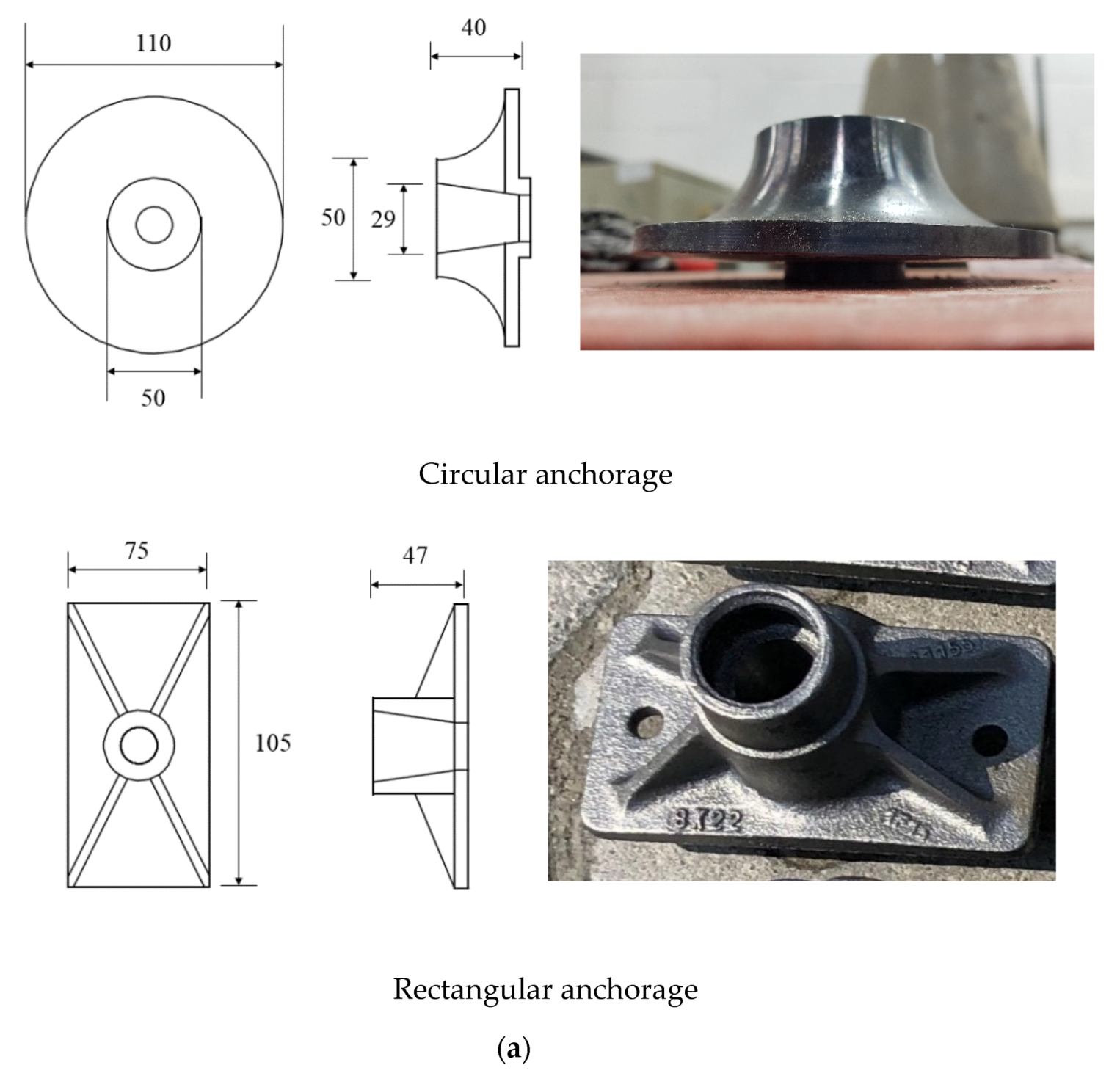

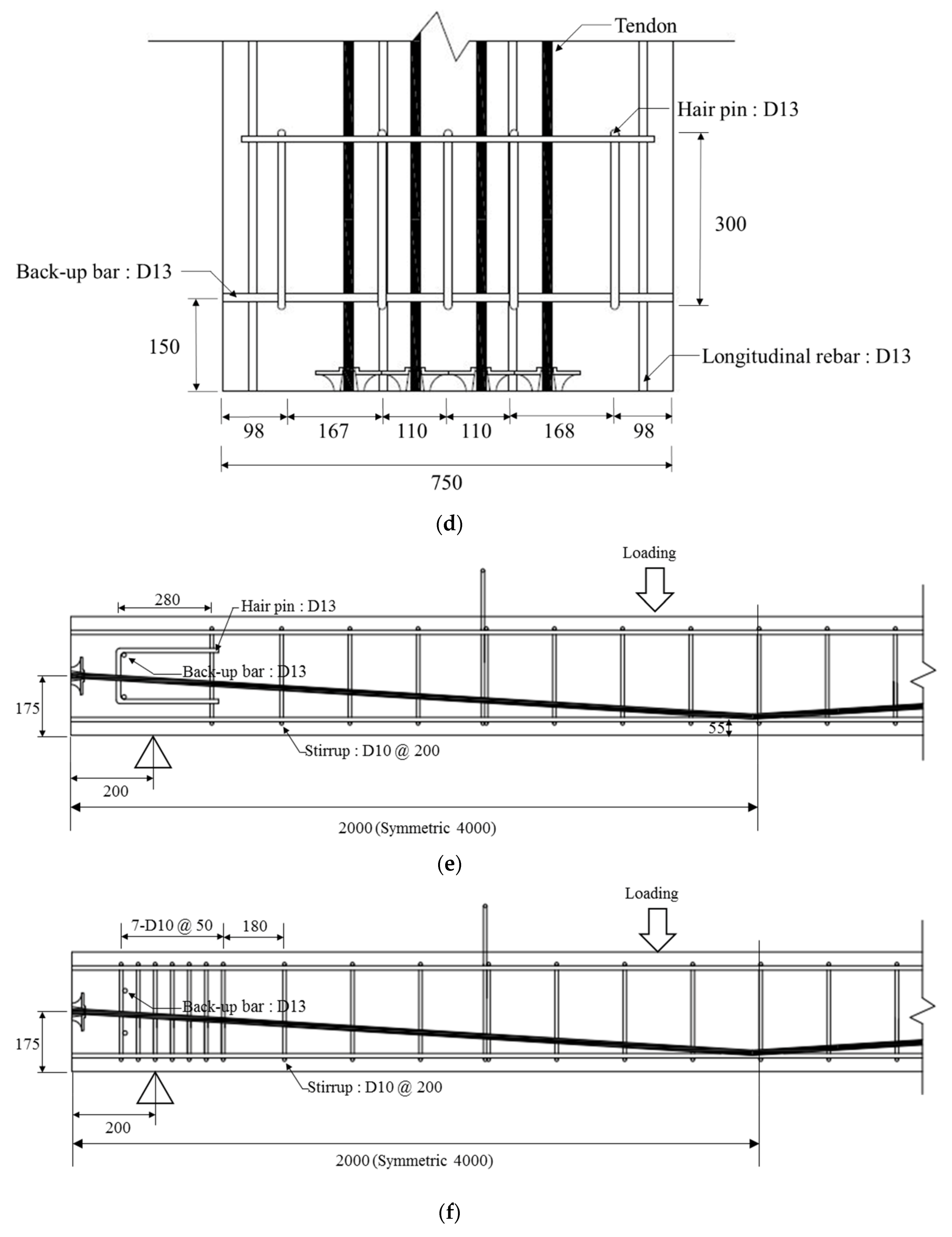
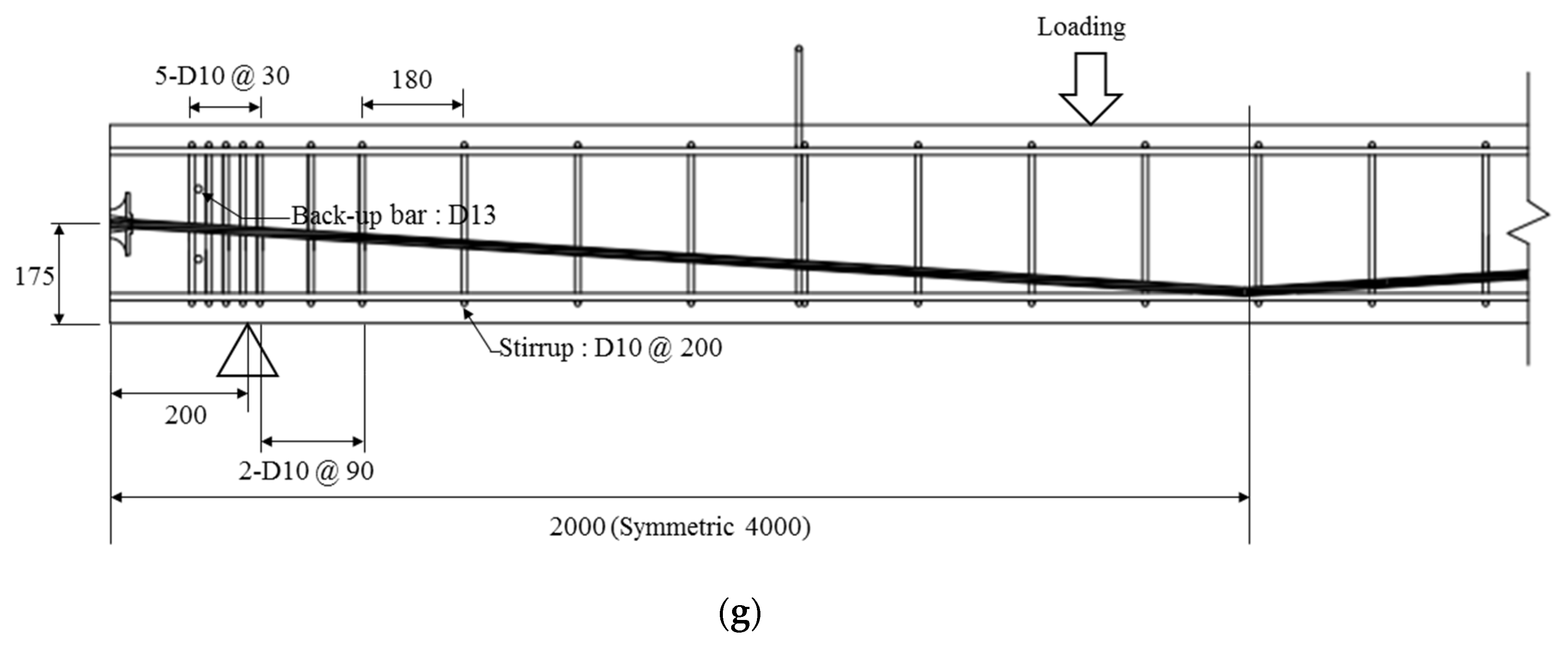
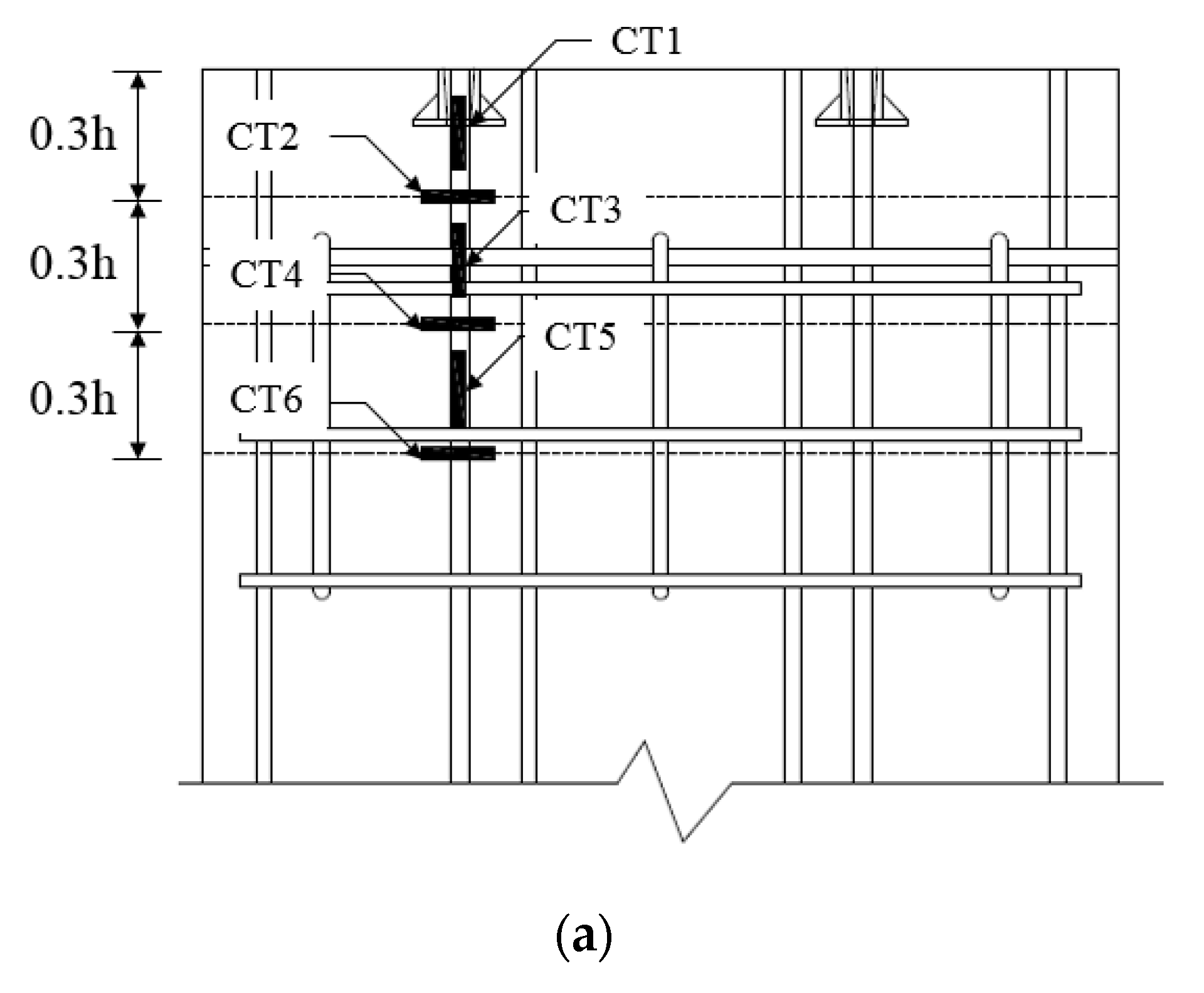
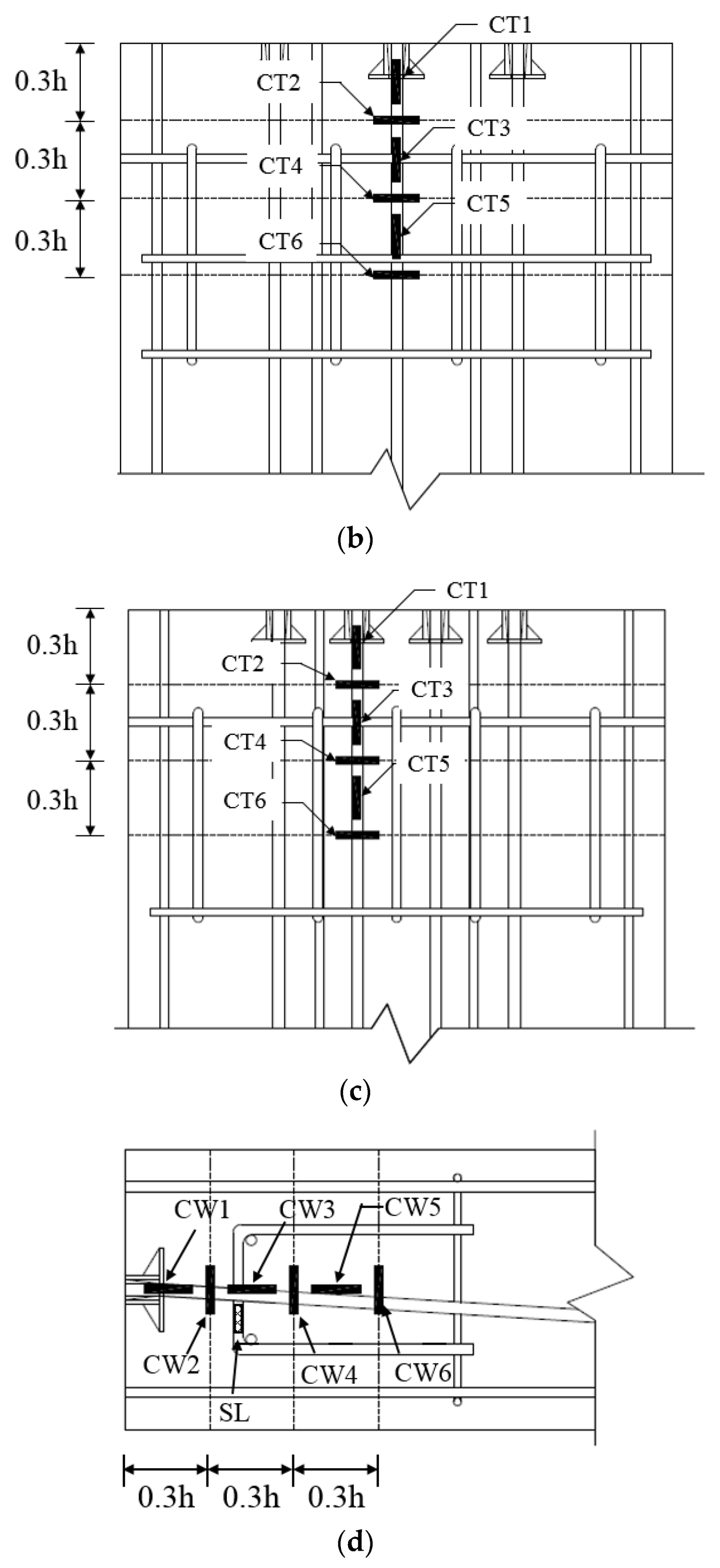
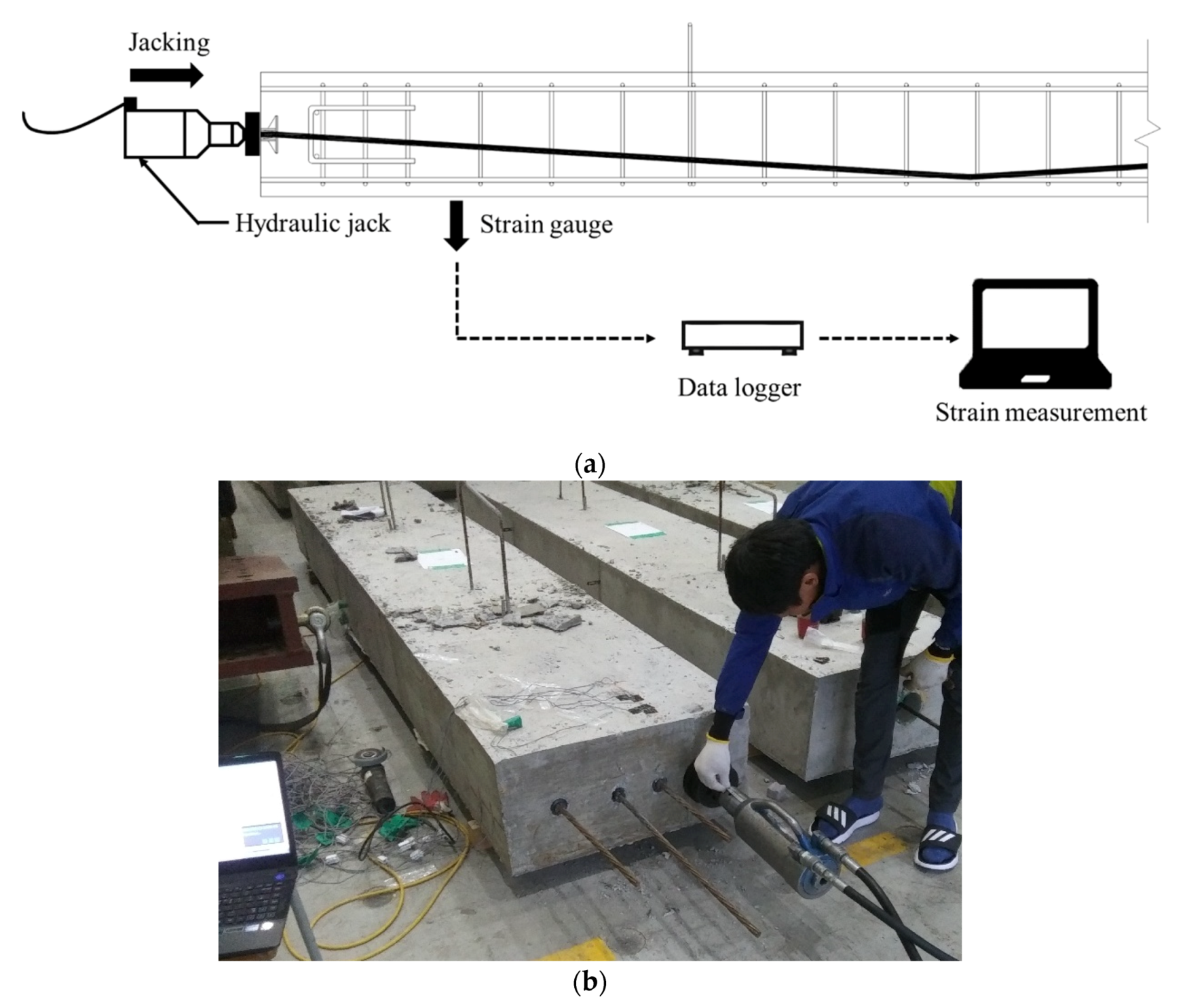
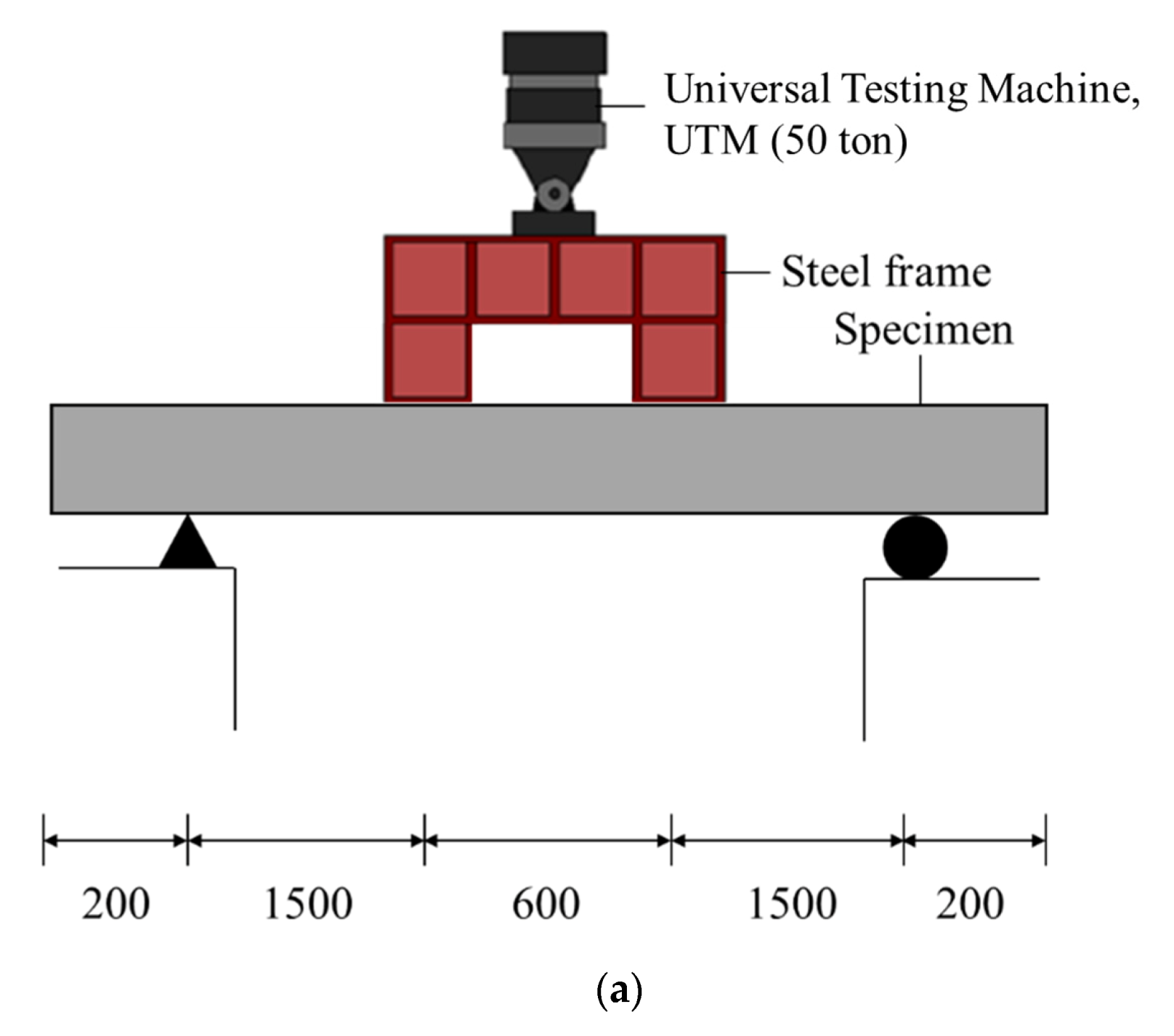
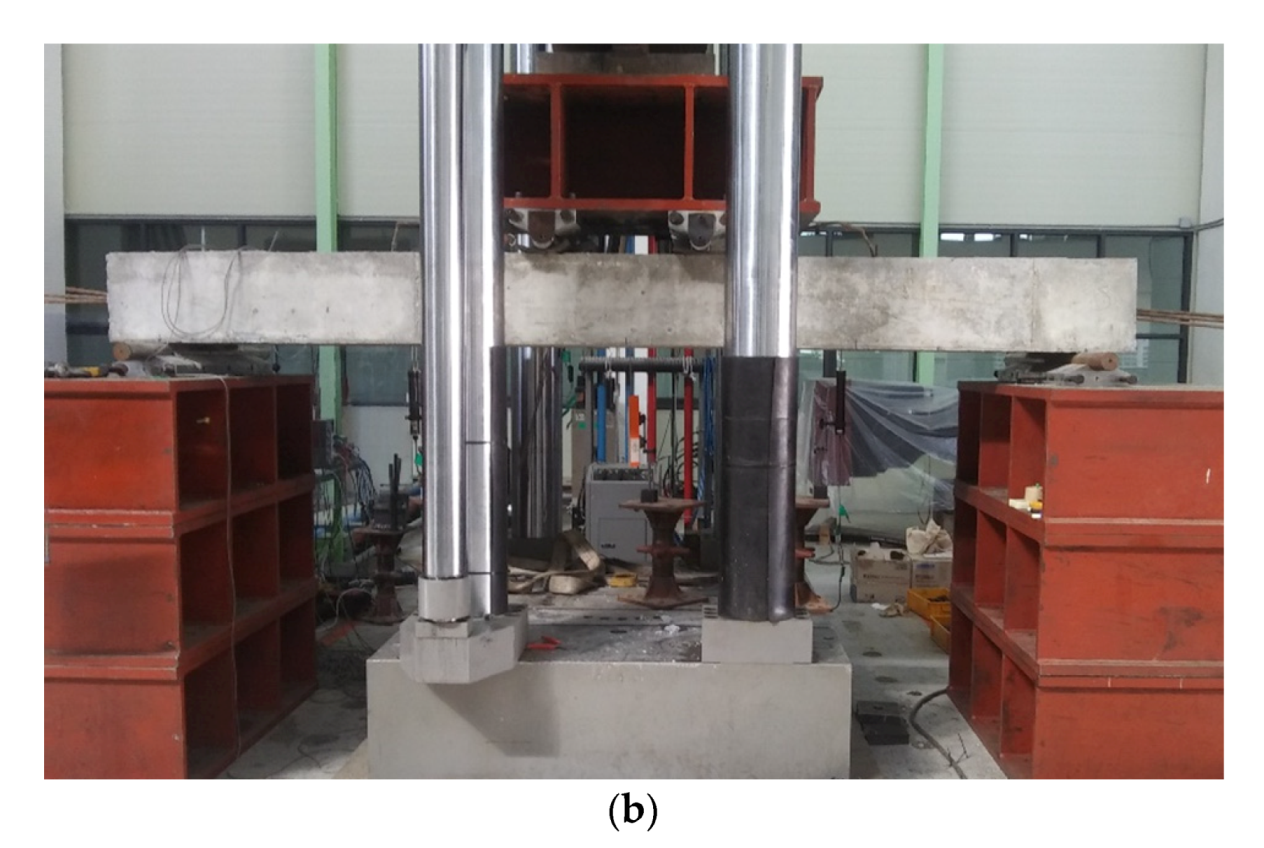


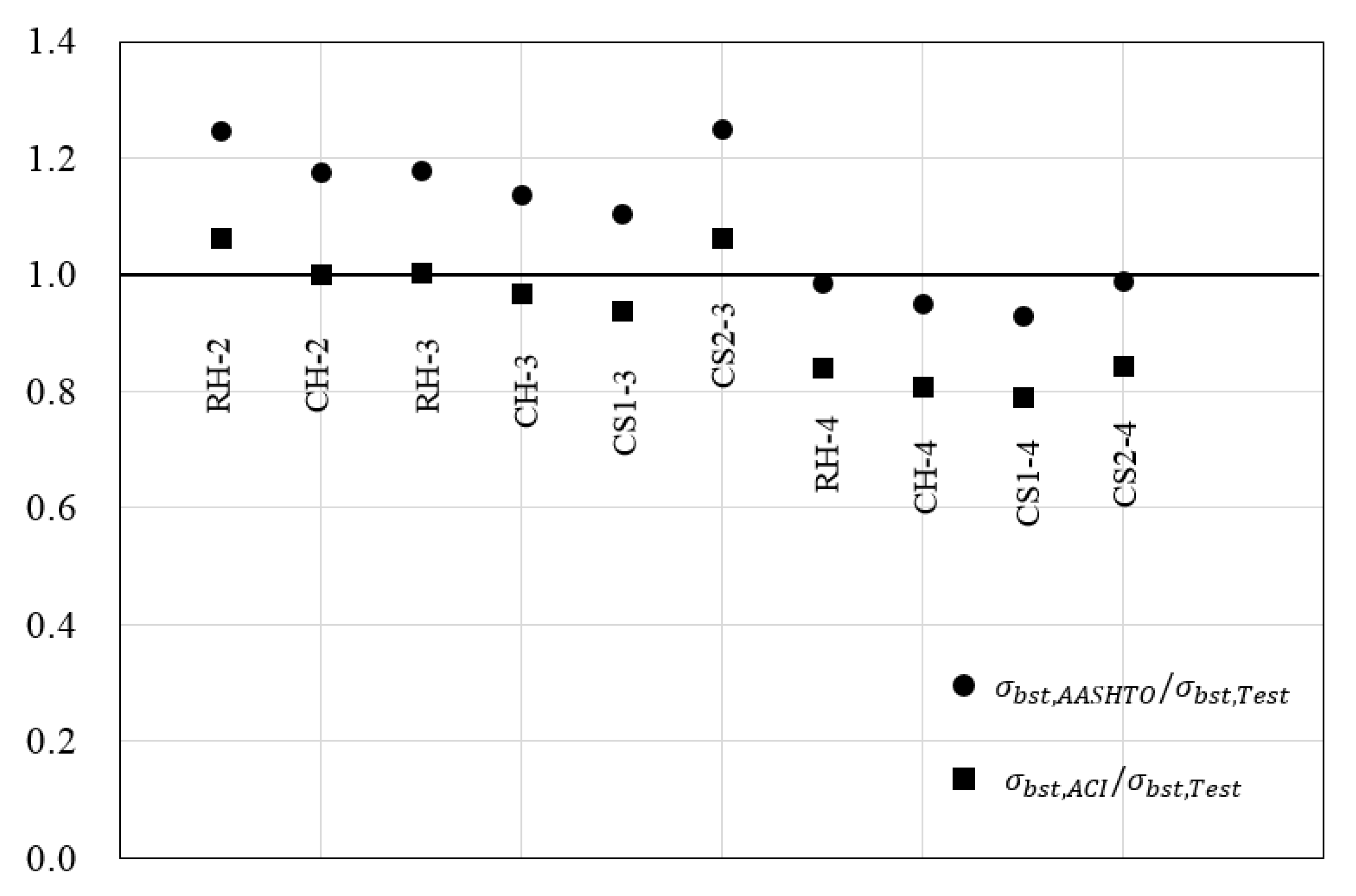
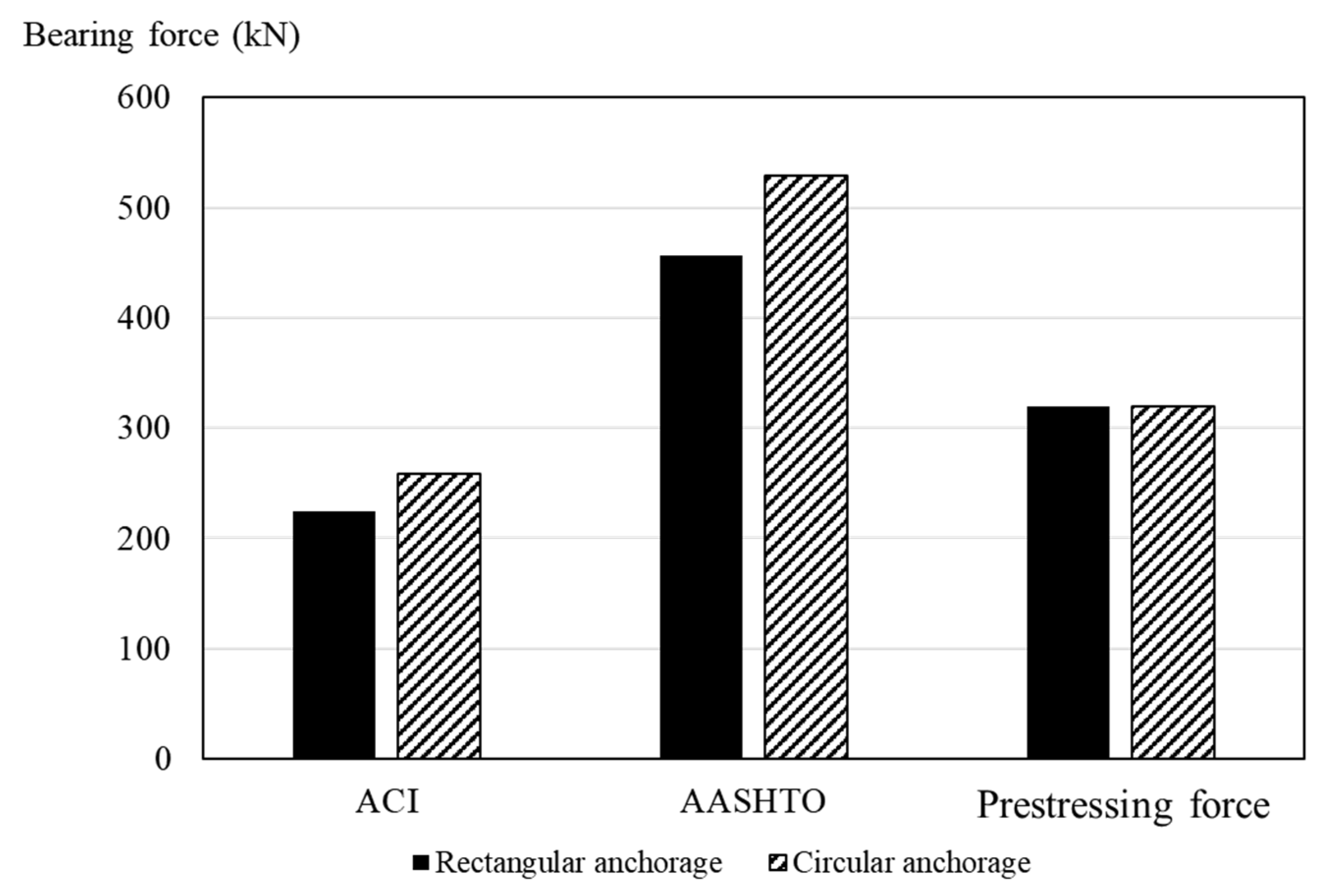

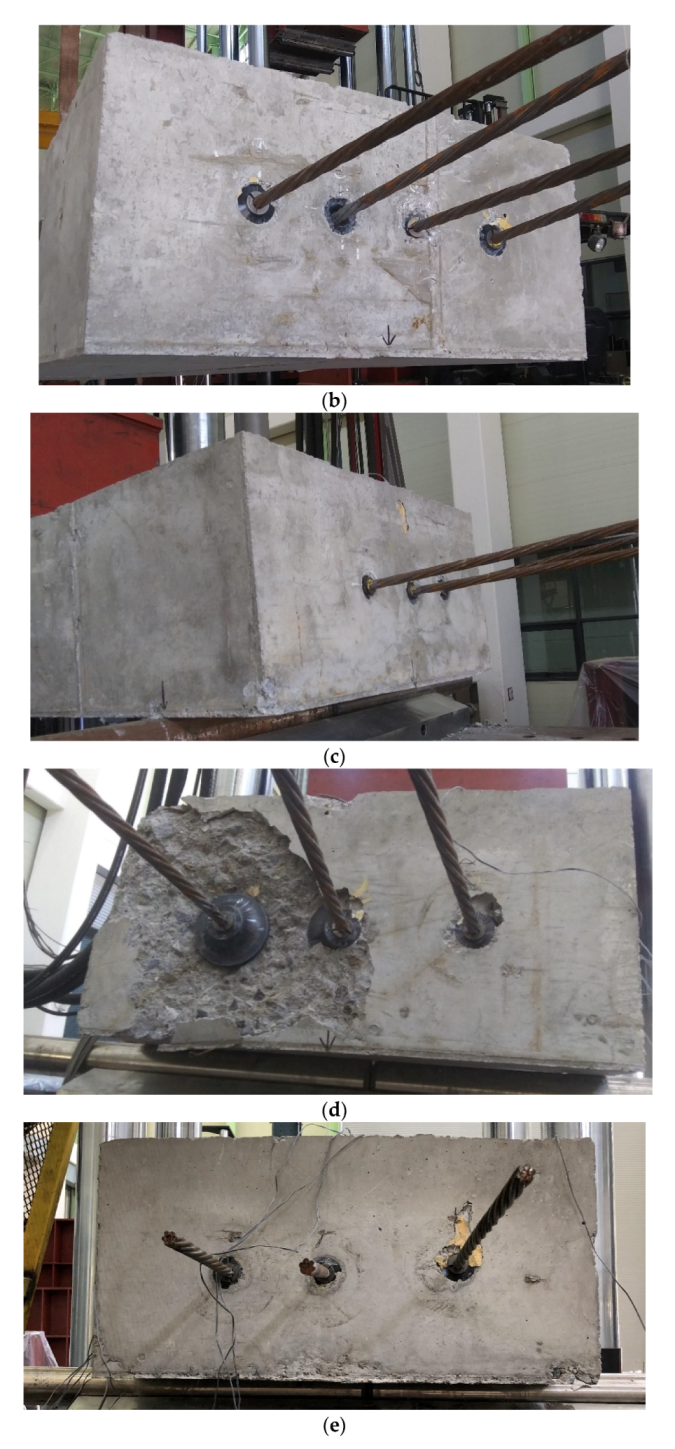
| Group | No | Specimen | (MPa) | (MPa) | (MPa) | Anchorage Shape | EA | e mm | Anchorage Zone Reinforcement |
|---|---|---|---|---|---|---|---|---|---|
| A | 1 | RH-2 | 35 | 400 | 2400 | Rectangular | 2 | 120 | Hairpin |
| 2 | CH-2 | Circular | 2 | ||||||
| 3 | RH-3 | Rectangular | 3 | ||||||
| 4 | CH-3 | Circular | 3 | ||||||
| 5 | RH-4 | Rectangular | 4 | ||||||
| 6 | CH-4 | Circular | 4 | ||||||
| B | - | CH-3 | Circular | 3 | Hairpin | ||||
| 7 | CS1-3 | 3 | Stirrup (Type1) | ||||||
| 8 | CS2-3 | 3 | Stirrup (Type2) | ||||||
| - | RH-4 | 4 | Hairpin | ||||||
| 9 | CS1-4 | 4 | Stirrup (Type1) | ||||||
| 10 | CS2-4 | 4 | Stirrup (Type2) |
| Group | No | Specimen | Bursting Stress (MPa) | |||||||
|---|---|---|---|---|---|---|---|---|---|---|
| Experimental Results | ACI | AASHTO | ||||||||
| Top View | Side View | |||||||||
| 0.3 h | 0.6 h | 0.9 h | 0.3 h | 0.6 h | 0.9 h | 0.5 h | 0.5 h | |||
| A | 1 | RH-2 | 0.66 | 0.43 | 0.19 | 0.52 | 0.41 | 0.11 | 0.69 | 0.82 |
| 2 | CH-2 | 0.70 | 0.45 | 0.18 | 0.62 | 0.37 | 0.14 | |||
| 3 | RH-3 | 1.04 | 0.73 | 0.48 | 0.78 | 0.60 | 0.42 | 1.04 | 1.22 | |
| 4 | CH-3 | 1.08 | 0.77 | 0.41 | 0.89 | 0.70 | 0.45 | |||
| 5 | RH-4 | 1.66 | 1.12 | 0.60 | 1.27 | 0.83 | 0.59 | 1.39 | 1.63 | |
| 6 | CH-4 | 1.72 | 1.16 | 0.74 | 1.38 | 0.91 | 0.63 | |||
| B | - | CH-3 | 1.08 | 0.77 | 0.41 | 0.89 | 0.70 | 0.45 | 1.04 | 1.22 |
| 7 | CS1-3 | 1.11 | 0.58 | 0.30 | 0.82 | 0.53 | 0.32 | |||
| 8 | CS2-3 | 0.98 | 0.45 | 0.27 | 0.84 | 0.47 | 0.30 | |||
| - | CH-4 | 1.72 | 1.16 | 0.74 | 1.38 | 0.91 | 0.63 | 1.39 | 1.63 | |
| 9 | CS1-4 | 1.76 | 0.82 | 0.41 | 1.26 | 0.72 | 0.38 | |||
| 10 | CS2-4 | 1.65 | 0.59 | 0.34 | 1.08 | 0.63 | 0.19 | |||
| Group | No | Specimen | Bearing Strain () | |||||
|---|---|---|---|---|---|---|---|---|
| Top View | Side View | |||||||
| 0.15 h | 0.45 h | 0.75 h | 0.15 h | 0.45 h | 0.75 h | |||
| A | 1 | RH-2 | 746.48 | 113.76 | 24.88 | 592.25 | 135.07 | 21.90 |
| 2 | CH-2 | 726.50 | 113.73 | 18.96 | 587.70 | 106.64 | 10.81 | |
| 3 | RH-3 | 1132.68 | 189.58 | 41.00 | 691.90 | 180.10 | 33.85 | |
| 4 | CH-3 | 947.88 | 163.58 | 36.78 | 618.45 | 172.51 | 30.33 | |
| 5 | RH-4 | 1350.70 | 547.38 | 71.10 | 921.50 | 300.93 | 68.27 | |
| 6 | CH-4 | 1195.00 | 537.93 | 59.72 | 870.85 | 372.03 | 54.10 | |
| B | - | CH-3 | 947.88 | 163.58 | 36.78 | 618.45 | 172.51 | 30.33 |
| 7 | CS1-3 | 1051.78 | 189.60 | 57.35 | 703.76 | 143.12 | 14.93 | |
| 8 | CS2-3 | 921.10 | 150.94 | 42.45 | 633.96 | 223.59 | 25.10 | |
| - | CH-4 | 1195.00 | 537.93 | 59.72 | 870.85 | 372.03 | 54.10 | |
| 9 | CS1-4 | 1415.15 | 456.60 | 26.42 | 959.43 | 428.30 | 49.24 | |
| 10 | CS2-4 | 1230.19 | 518.87 | 53.58 | 904.16 | 299.06 | 25.47 | |
| Group | No | Specimen | (kN) | Strain () | ||
|---|---|---|---|---|---|---|
| Steel | Concrete | |||||
| SL Gauge | CT1 Gauge | CT2 Gauge | ||||
| A | 1 | RH-2 | 322.68 | −90 | 20 | −46 |
| 2 | CH-2 | 287.21 | −46 | 15.2 | −43 | |
| 3 | RH-3 | 430.16 | −191 | 136 | −13 | |
| 4 | CH-3 | 420.84 | −149 | 39 | N/A | |
| 5 | RH-4 | 461.89 | −61 | 74 | −134 | |
| 6 | CH-4 | 482.63 | −107 | 18 | −35 | |
| B | - | CH-3 | 420.84 | −149 | 39 | −103 |
| 7 | CS1-3 | 438.95 | −92 | 34 | −26 | |
| 8 | CS2-3 | 443.96 | −29 | 25 | −45 | |
| - | CH-4 | 482.63 | −107 | 18 | −35 | |
| 9 | CS1-4 | 504.05 | −276 | 27 | −44 | |
| 10 | CS2-4 | 497.31 | N/A | 10 | −25 | |
© 2020 by the authors. Licensee MDPI, Basel, Switzerland. This article is an open access article distributed under the terms and conditions of the Creative Commons Attribution (CC BY) license (http://creativecommons.org/licenses/by/4.0/).
Share and Cite
Ro, K.M.; Kim, M.S.; Lee, Y.H. Validity of Anchorage Zone Design for Post-Tensioned Concrete Members with High-Strength Strands. Appl. Sci. 2020, 10, 3039. https://doi.org/10.3390/app10093039
Ro KM, Kim MS, Lee YH. Validity of Anchorage Zone Design for Post-Tensioned Concrete Members with High-Strength Strands. Applied Sciences. 2020; 10(9):3039. https://doi.org/10.3390/app10093039
Chicago/Turabian StyleRo, Kyong Min, Min Sook Kim, and Young Hak Lee. 2020. "Validity of Anchorage Zone Design for Post-Tensioned Concrete Members with High-Strength Strands" Applied Sciences 10, no. 9: 3039. https://doi.org/10.3390/app10093039





